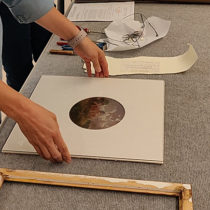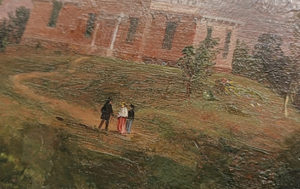Magazine

Cropsey Up Close
by Lara Zielin
Before it had a furnace or running water or indoor plumbing, the University of Michigan president’s house had two paintings by Jasper Cropsey. They hung in the home’s parlor beginning in 1855, when Henry Phillip Tappan was president. Tappan, who was a friend of Cropsey, had been able to get the Regents to approve a twenty-five dollar expenditure to have Cropsey paint the Detroit Observatory and U-M’s campus.
But when Tappan was fired and left U-M, the paintings were sold. They went up for auction and were eventually purchased by Herbert Randall, who ran a photographic studio in Ann Arbor.

A close-up showing the minute details in one of Copsey’s U-M paintings.
Randall held onto the paintings until 1890, when Andrew Dickson White from Ithaca, New York, purchased them. White had been had been a professor of English literature and history at U-M before becoming Cornell University’s first president. White ensured the paintings made it back to Ann Arbor, and a letter from U-M president James Angell in 1890 counted this among the “many debts” the University owed White.
Nearly a century later, in 1974, the paintings underwent conservation treatment by the Intermuseum Conservation Association in Oberlin, Ohio. After fixing a host of issues, conservators sent them back to Ann Arbor in care of the U-M Museum of Art (UMMA). They hung in UMMA until recently, when they were pulled off the wall once again—this time to be digitized.
This process involved bringing the two paintings to the Bentley, where conservation staff carefully removed the paintings from their frames and prepared them to be scanned. They were sent over to the Digital Conservation Unit at U-M Library, where they were digitized.
Up close, the tiny, intricate details of the paintings are visible. This meticulous style would continue as Cropsey distinguished himself as a Hudson Valley artist and as the founder of the American Society of Painters in Watercolor.
